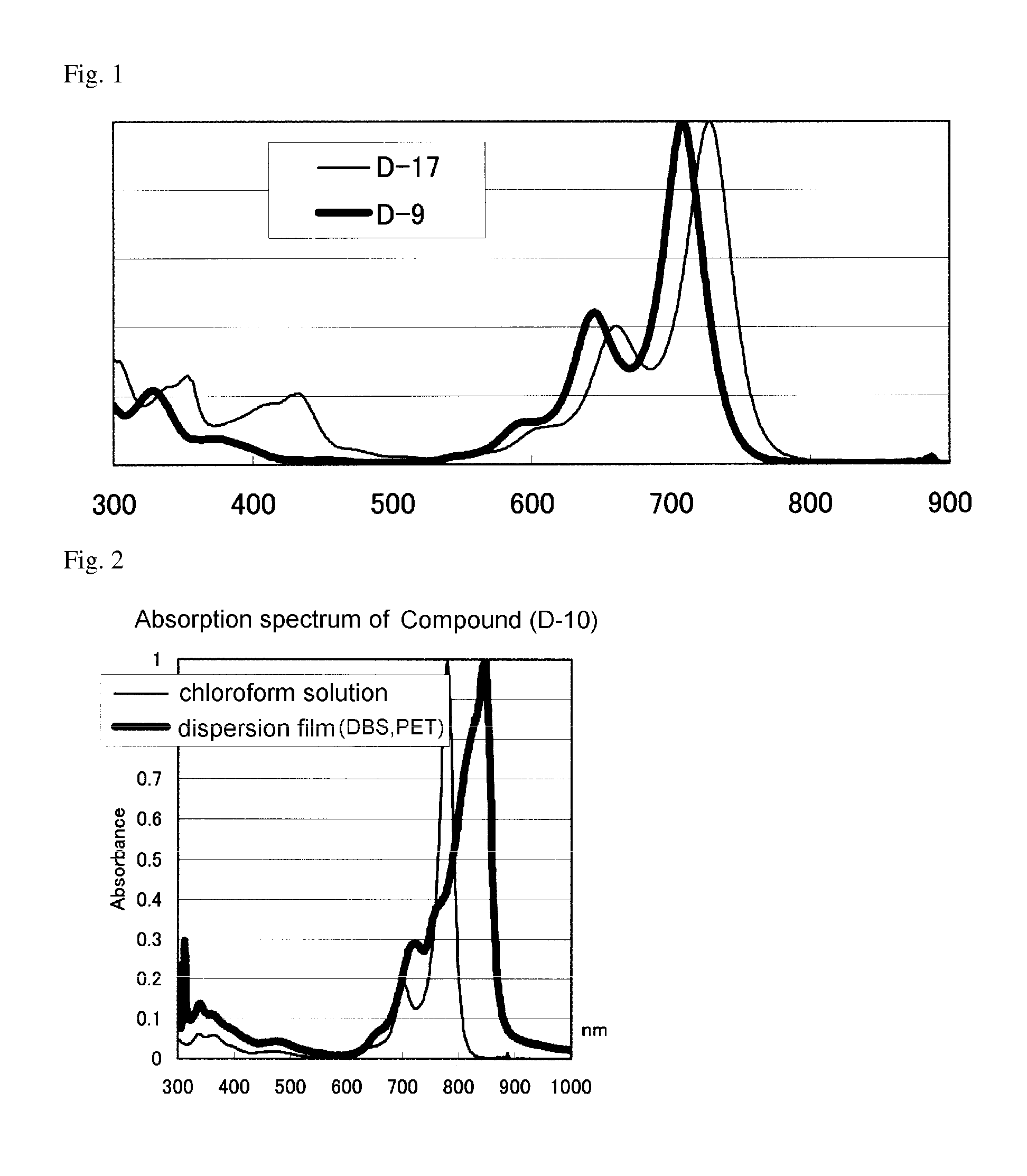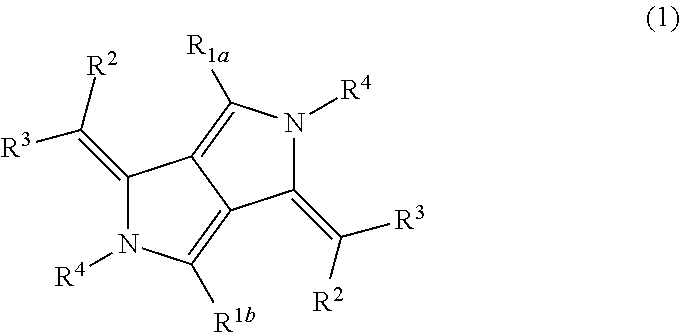Infrared absorptive compound, and fine particle containing the compound
- Summary
- Abstract
- Description
- Claims
- Application Information
AI Technical Summary
Benefits of technology
Problems solved by technology
Method used
Image
Examples
example 1
Preparation of Exemplified Compound (D-1)
[0112]An exemplified compound (D-1) was prepared in accordance with the following scheme.
[0113]First, a diketopyrrolopyrrole compound (DPP) was synthesized in accordance with a method described in U.S. Pat. No. 5,969,154, using 4-(2-ethylhexyloxy)benzonitrile as a starting material.
[0114]In 60 mL of toluene, 3 g (1 equivalent by mol) of the diketopyrrolopyrrole compound, and 1.6 g (2.5 equivalents by mol) of pyridineacetonitrile were stirred, and then thereto was added 6.5 g (8 equivalents by mol) of phosphorus oxychloride. The solution was heated and refluxed for 4 hours. The solution was cooled to room temperature, and then thereto were added 50 mL of chloroform and 20 mL of water. Furthermore, the solution was stirred for 30 minutes. Therefrom, the organic layer was taken out by a liquid-separating operation. The organic layer was washed with an aqueous sodium hydrogen carbonate solution, and then the solvent was distilled off under reduce...
example 2
Preparation of Exemplified Compound (D-25)
[0116]An exemplified compound (D-25) was prepared in accordance with the following scheme.
[0117]In 20 mL of o-dichlobenzene, 0.75 g (1 equivalent by mol) of the exemplified compound (D-1) and 0.5 g (2.5 equivalents by mol) of chlorodiphenyl borone were heated and refluxed for 3 hours. The solution was cooled to room temperature, and then thereto were added 10 mL of water. Therefrom, the organic layer was taken out by a liquid-separating operation. The organic layer was washed with an aqueous sodium hydrogen carbonate solution, and then the solvent was distilled off under reduced pressure. The obtained crude product was purified by silica gel column chromatography (solvent: chloroform), and further a chloroform / methanol solvent was used to recrystallize the purified product to yield 0.58 g of the target compound (D-25) (yield: 53%).
[0118]1H-NMR (CDCl3): δ0.9-1.0 (m, 12H), 1.3-1.6 (m, 16H), 1.8 (m, 2H), 3.75 (d, 4H), 6.35 (d, 4H), 6.65 (d, 4H)...
example 3
Preparation of Exemplified Compound (D-30)
[0119]An exemplified compound (D-30) was prepared in accordance with the following scheme.
[0120]In 20 mL of o-dichlobenzene, 1 g (1 equivalent by mol) of the exemplified compound (D-1) and 0.5 g (2.5 equivalents by mol) of borone trifluoride diethylether complex were heated and refluxed for 1 hour, and then thereto was added 0.75 g (5 equivalents by mol) of diisopropylmethylamine. The solution was further heated and refluxed for 1 hour. The solution was cooled to room temperature, and then thereto were added 10 mL of water. Therefrom, the organic layer was taken out by a liquid-separating operation. The solvent was distilled off under reduced pressure. The obtained crude product was purified by silica gel column chromatography (solvent: chloroform), and further a chloroform / methanol solvent was used to recrystallize the purified product to yield 0.8 g of the target compound (D-30) (yield: 70%).
[0121]1H-NMR (CDCl3): δ0.9-1.0 (m, 12H), 1.3-1.6...
PUM
| Property | Measurement | Unit |
|---|---|---|
| Wavelength | aaaaa | aaaaa |
| Wavelength | aaaaa | aaaaa |
Abstract
Description
Claims
Application Information
 Login to View More
Login to View More - R&D
- Intellectual Property
- Life Sciences
- Materials
- Tech Scout
- Unparalleled Data Quality
- Higher Quality Content
- 60% Fewer Hallucinations
Browse by: Latest US Patents, China's latest patents, Technical Efficacy Thesaurus, Application Domain, Technology Topic, Popular Technical Reports.
© 2025 PatSnap. All rights reserved.Legal|Privacy policy|Modern Slavery Act Transparency Statement|Sitemap|About US| Contact US: help@patsnap.com



